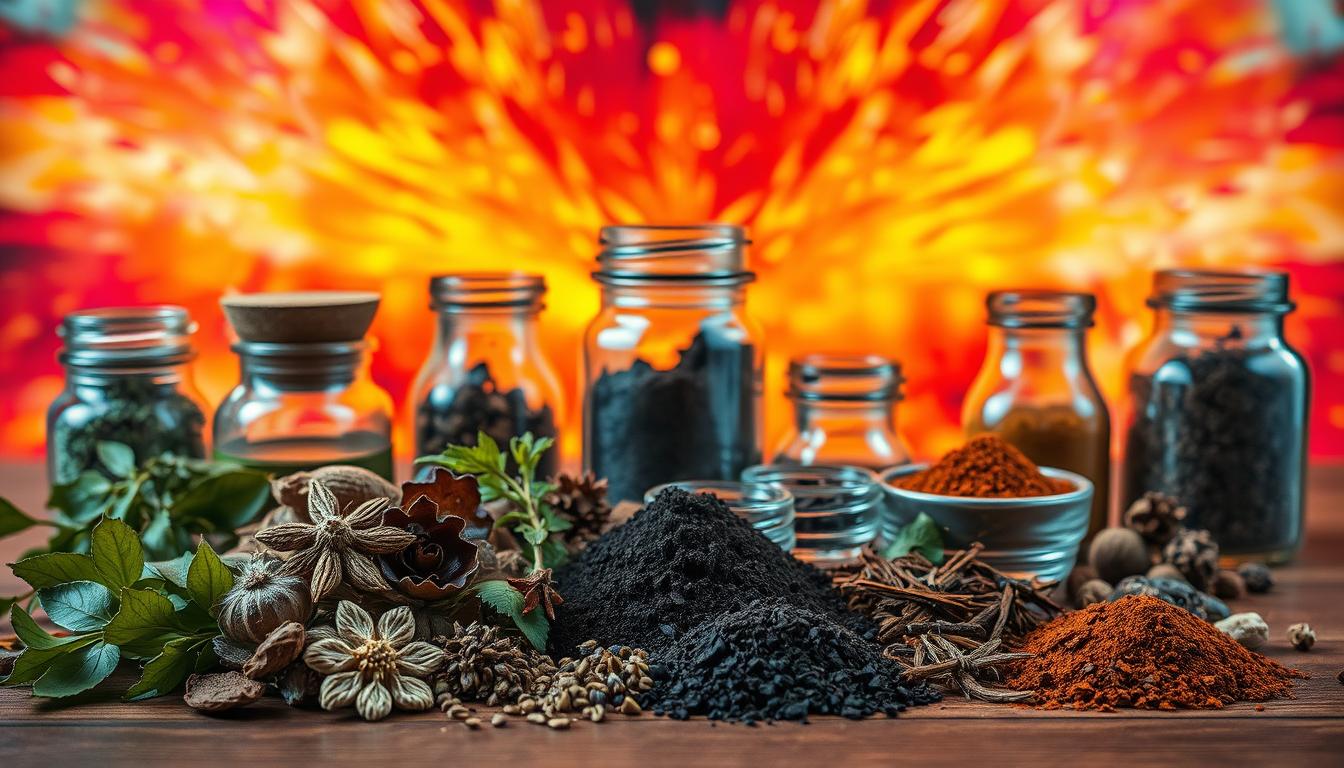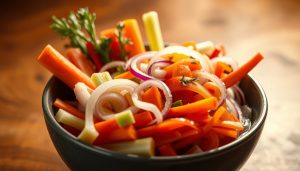A steaming bowl of broth can become a masterpiece. The right additions can turn a simple broth into a rich, layered experience. Whether it’s a cozy weeknight meal or an elegant starter, the key is in your seasoning.
Don’t just use salt and pepper. Try toasted cumin seeds or smoked paprika for depth. Fresh rosemary or lemongrass can brighten the flavors. Even small changes, like citrus zest or chili oil, can make a big difference.
Modern kitchens love global flavors. A spoonful of Thai curry paste or a dash of za’atar can change a recipe’s character. Don’t forget about pantry staples like canned chipotles or sun-dried tomatoes. Each addition should enhance, not overpower.
Key Takeaways
- Layer flavors using fresh and dried ingredients for complexity
- Umami-rich components like miso or mushrooms elevate depth
- Toast whole spices briefly to intensify their aroma
- Acidic finishes (lemon juice, vinegar) brighten heavy broths
- Experiment with global seasonings for unexpected twists
- Infuse oils or butters with herbs for instant flavor upgrades
- Homemade stock provides a cleaner foundation than store-bought
Understanding Soup Flavor Foundations
Great soup starts long before you heat it up. It begins with mastering the basics of taste. Professional chefs like Claire Saffitz say that flavor architecture is key. It makes your broth sing or fall flat. Let’s look at the basics every home cook needs to improve their soup.

The Flavor Trinity: Salt, Fat, and Acid Balance
Your soup’s success depends on three key elements working together. Salt brings out natural flavors but must be used carefully. Bon Appétit’s test kitchen suggests seasoning in stages, not all at once.
Fat carries flavors; use olive oil for Mediterranean tastes or butter for creamy soups. A splash of acid (like lemon juice or vinegar) brightens the soup. Add it just before serving for the best effect.
“Building stock is like composing music – you need the right notes (ingredients) at the right volume (quantity) in the right order (technique).”
Layering Ingredients for Depth
Professional kitchens use a strategic approach to flavor development:
- Sauté aromatics first (onions, garlic) to create flavor foundation
- Add hearty vegetables in order of cooking time – carrots before zucchini
- Deglaze with wine or broth to capture browned bits
- Incorporate herbs at specific stages – rosemary early, parsley late
This low and slow method builds complex flavors. Remember, browning meat before simmering adds depth you can’t get from boiling alone.
Common Soup Flavor Pitfalls to Avoid
Even experienced cooks make these mistakes:
- Over-salting during early cooking stages (liquids reduce!)
- Using raw flour directly in broth (creates chalky texture)
- Neglecting acid balance in cream-based soups
- Overcrowding with competing spices
- Using stale dried herbs past their prime
To fix bland soups, add umami boosters like tomato paste or soy sauce. For oversalted soups, add diced potatoes to absorb excess salt. Or dilute with unsalted stock.
Essential Herbs for Soup Enhancement
Herbs can turn good soups into memorable culinary experiences. Whether it’s a hearty minestrone or a light pho, the right herbs and timing make all the difference. They take flavors from good to great.
Fresh vs Dried: Choosing Your Flavor Tools
Dried herbs have strong flavors, perfect for long-cooked soups. Fresh herbs add a burst of flavor at the end. Chef José Andrés says:
“Fresh herbs are living ingredients – treat them like delicate flowers, not bulletproof flavor soldiers.”
- Use dried herbs when: Making stocks, cooking soups over 45 minutes, or working with hearty legumes
- Choose fresh herbs for: Garnishes, quick-cooking broths, and delicate vegetable soups

Mastering Herb Timing
Adding herbs at the right time makes all the difference. Here’s a guide to follow:
Early Cooking Herbs (Rosemary, Thyme)
Woody herbs do well in long cooking times. Add them early to:
- Infuse oils with aromatic compounds
- Withstand 2+ hours of simmering
- Create deep background flavors
Finish Herbs (Parsley, Cilantro)
Add delicate herbs in the last 5 minutes to:
- Preserve volatile oils that evaporate quickly
- Maintain bright color and texture
- Add fresh top notes to rich broths
Global Herb Pairings Made Simple
Each cuisine has its own herb combinations that harmonize perfectly with local ingredients:
| Cuisine | Core Herbs | Soup Example |
|---|---|---|
| Mediterranean | Oregano + Basil + Bay Leaf | Tomato Lentil |
| Asian | Lemongrass + Thai Basil + Kaffir Lime | Tom Yum |
| Latin American | Cilantro + Epazote + Mexican Oregano | Pozole Verde |
Powerhouse Spices for Soup Depth
Spices are the secret to making soups rich and complex. While herbs add freshness, spices bring warmth and earthiness. This creates layers of flavor. Let’s look at how to use them well in your soup.
Whole vs Ground Spice Applications
Whole spices are great for long-simmered soups. They release flavors slowly and keep their texture. Use them for a subtle flavor, like cinnamon sticks in Moroccan harira or whole cloves in beef stew. Grind them fresh for the best aroma.

Ground spices are best for quick soups like tomato bisque or lentil soup. They mix in fast but lose flavor quickly. Replace them every 6 months for the best taste.
| Form | Best Uses | Shelf Life |
|---|---|---|
| Whole | Simmered soups | 2-4 years |
| Ground | Quick soups | 6 months |
Toasting Techniques for Maximum Flavor
Wake up the oils in spices with these methods:
- Dry pan method: Toast over medium heat 2-3 minutes until fragrant
- Oven method: Bake whole spices at 325°F for 8-10 minutes
Cool toasted spices completely before grinding. This prevents bitterness.
Global Spice Profiles
Mediterranean (Paprika, Cumin)
Smoked paprika adds depth to Spanish garlic soup. Cumin is great in Turkish red lentil soups. Add bay leaves and oregano for real flavor.
Asian (Star Anise, Lemongrass)
Star anise makes Vietnamese pho broth special. Lemongrass brightens Thai tom yum. Mix with ginger and kaffir lime leaves for a balanced taste.
Umami-Boosting Secret Ingredients
Unlocking umami’s potential can turn good soups into unforgettable ones. Chefs around the world use hidden enhancers to add savory richness. These ingredients enhance flavors without overpowering them. Let’s explore fermented staples and vegetable surprises that will make your broth sing.

Fermented Flavor Powerhouses
Fermentation creates complex tastes that stock alone can’t match. These ingredients work like flavor amplifiers – a little goes a long way.
Miso Paste Applications
White miso shines in light broths, while red miso boosts heartier stews. Always dissolve it in warm broth before adding to prevent clumping. Stir it in during the last 10 minutes to preserve its probiotic benefits.
Fish Sauce Dosage Tips
Start with ¼ tsp per quart – it’s stronger than you think! For vegan options, combine mushroom powder with soy sauce. The magic happens when fish sauce blends completely – never add it directly to boiling liquid.
Unexpected Vegetable Boosters
Who says umami only comes from meat? These plant-based heroes deliver deep, satisfying flavors that meat-eaters crave.
Sun-Dried Tomato Magic
Oil-packed tomatoes add sweetness and tang to minestrone or lentil soup. Blend them into creamy bases or chop finely for texture. For fat-free versions, soak dried tomatoes in broth before pureeing.
Mushroom Powder Uses
This secret weapon works in every soup style:
- Sprinkle into broth during simmering
- Mix with salt for finishing seasoning
- Boost vegan “cream” soups
Make your own by dehydrating shiitakes or portobellos. Store-bought blends work too – just check for additives. The powder’s concentrated flavor means 1 tsp equals 8 oz fresh mushrooms.
Experiment with these enhancers gradually. Start with small amounts and taste as you go – your soup’s depth will surprise you!
Dairy and Non-Dairy Enrichers
Creating a smooth bisque or a plant-based chowder needs the right enrichments. These add texture and depth of flavor. Dairy and non-dairy options each have their own benefits. The trick is knowing how to use them and when.

Cream and Yogurt Incorporation
Heavy cream makes soups silky, but heating it wrong can cause it to curdle. To avoid this, always:
- Whisk cold cream into hot soup slowly
- Keep the temperature below 180°F (82°C)
- Use full-fat yogurt for creamy swirls
Bon Appétit suggests a way to prevent yogurt from separating: “Spoon dollops onto chilled soup surfaces, then gently fold using figure-eight motions.” For vegan creaminess, try:
| Thickener | Best For | Activation Temp |
|---|---|---|
| Cashew Cream | Potato soups | Room temp |
| Coconut Milk | Curries | Simmering (160°F) |
| Silken Tofu | Brothy soups | Blended cold |
Nutritional Yeast for Vegan Options
Nutritional yeast gives a cheesy taste without using dairy. Here are three ways to use it well:
- Bloom 1 tbsp in hot broth before adding other ingredients
- Combine with soaked cashews for a creamy texture
- Mix with smoked paprika for a smoky flavor
“Nutritional yeast isn’t just a substitute – it’s a flavor amplifier that works in any cuisine.”
For a nut-free option, blend steamed cauliflower with miso paste and olive oil. Remember to adjust the seasoning after adding thickeners. Their sodium levels can vary a lot.
Acidic Brighteners
Acidic ingredients are like highlights in a painting, making soup flavors pop. They cut through richness and balance out flavors. Professional chefs say acid is the secret weapon for amazing soups.

Citrus Zest and Juice Pairings
Citrus adds a burst of sunshine to soups. Use zest for a strong aroma without too much acidity. Juice is best added just before serving to keep its brightness.
| Citrus Type | Best Soup Pairings | Preparation Tip |
|---|---|---|
| Lemon | Chicken noodle, minestrone | Zest before juicing |
| Lime | Tom yum, tortilla | Use juice sparingly |
| Orange | Butternut squash, lentil | Combine zest with cinnamon |
Lemon verbena adds a herbal citrus touch to consommés. Lime juice adds a zing to spicy soups. Always taste as you go, as acidity changes with season and variety.
Vinegar Selection Guide
Vinegars add depth that grows during cooking. Sherry vinegar enhances French onion soup, while rice wine vinegar brightens miso ramen. Here are some pairing tips:
- Balsamic: Tomato-based soups
- Apple cider: Bean and bacon chowders
- Champagne: Cream of mushroom
Don’t add vinegar while boiling. Heat can ruin flavors. Instead, add ½ teaspoon at a time during final seasoning. Rice wine vinegar adds brightness to vegan pho.
“Acid adjustment is the last critical step in soup-making – it’s like turning up the volume on all your ingredients.”
Allium Family Fundamentals

Every great soup starts with the allium family’s flavors. These veggies are key in many cuisines. They add sweetness, pungency, and depth to soups.
Onion Varietal Differences
Yellow onions are best for savory soups because of their sulfur. This makes them taste rich and umami when cooked. Sweet onions like Vidalia are great for soups that need a bit of sweetness.
For quick soups, use red onions raw or white onions for Mexican flavors. Pearl onions are good in stews after blanching.
Caramelizing onions makes them sweet. Sweating them keeps their fresh taste. Choose your method based on the flavor you want.
Garlic Preparation Techniques
How you prepare garlic changes your soup’s taste. Minced garlic adds lots of flavor fast. It’s perfect for adding at the end.
For a gentle flavor, slice garlic thinly. Roasting whole heads makes garlic milder. Black garlic adds a unique, earthy taste.
Crush garlic cloves with a knife before chopping. This helps release more flavor.
Leeks and Shallots Special Uses
Leeks and shallots make soups special. They’re used in specific ways to enhance flavors:
| Ingredient | Best Use | Prep Tip |
|---|---|---|
| Leeks | Cream soups | Slice white parts only, rinse thoroughly |
| Shallots | French onion soup | Fine dice for even distribution |
Leeks add a soft onion taste without being too strong. Shallots sweeten wine-based broths. For strong flavor without texture, use leek greens in cheesecloth in simmering stock.
Root Vegetable Flavor Bases

Root vegetables are key to a rich soup base. They add sweetness, depth, and texture. Let’s see how to use them for amazing soup seasoning ideas.
Carrot Sweetness Balancing
Carrots add color and sweetness to soups. But, their sugar can be too much. Balance them with acidic ingredients like tomatoes or apple cider vinegar. Roasting carrots first helps in creamy soups, reducing their sugar.
Grate carrots into soups like minestrone or chicken noodle. It spreads their sweetness evenly, blending well with other flavors.
Celery Leaf Utilization
Don’t throw away celery leaves! They have more flavor than stalks, with herbal notes like parsley. Chop them finely for garnishes or blend into pesto for fresh flavor.
- Add leaves during the last 10 minutes of simmering
- Mix with olive oil and garlic for compound butter
- Dehydrate for homemade celery salt
Parsnip Earthy Notes
Parsnips make stocks rich when used right. Roasting brings out nutty flavors, while boiling keeps earthiness. For chowders or bisques, roast and boil:
- Roast half your parsnips until caramelized
- Simmer raw pieces in broth
- Blend together for layered flavor
This mix creates depth that store-bought seasonings can’t. Add thyme or smoked paprika to enhance their warmth.
Bone Broth vs Vegetable Stock
Choosing between bone broth and vegetable stock can change your soup’s taste a lot. Both add depth, but they’re different in nutrition and flavor. Let’s look at how each affects your cooking and when to use them best.

Why Homemade Stock Wins for Flavor Control
Homemade stock lets you customize every layer of taste. Bone broth, simmered for hours, releases collagen for a velvety feel. It’s great for hearty stews. Vegetable stocks, especially with kombu seaweed, add natural umami without meat.
Chef Claire Saffitz says, “Roasting bones or mushrooms before simmering unlocks deeper, caramelized notes you can’t get from store-bought versions.”
Homemade stock also avoids hidden additives found in commercial products. A basic batch needs just three things:
- Animal bones or vegetable scraps
- Cold water
- Time (4-24 hours for bone broth)
Navigating the Store-Bought Aisle Like a Pro
When buying pre-made stocks, check the label first. Many brands add dextrose or artificial flavors that don’t mix well with homemade soup flavorings. Look for these good signs:
| Brand Type | Sodium per Cup | Key Ingredients |
|---|---|---|
| Organic Bone Broth | ≤ 300mg | Chicken bones, apple cider vinegar |
| Low-Sodium Veg Stock | ≤ 150mg | Kombu, shiitake, onion |
For quick fixes, add fresh herbs or a splash of vinegar to store-bought bases. Freeze leftover stock in ice cube trays. Drop one into sauces or grains for instant flavor.
Infused Oils and Compound Butters
Take your soups to the next level with secret ingredients for soup that chefs love: infused oils and compound butters. These add a restaurant-quality touch to your soups. You can adjust the flavor to your liking by adding just the right amount.

Herb-Infused Oil Recipes
Using cold-steeped oils keeps the delicate flavors of herbs intact. Here’s how to do it:
- Pack fresh rosemary or thyme in sterilized jars
- Cover with high-quality olive oil (1:3 herb-to-oil ratio)
- Store in a dark cabinet for 72 hours
| Method | Best For | Infusion Time |
|---|---|---|
| Cold-Steep | Basil, dill, parsley | 3-5 days |
| Heated | Garlic, chili, rosemary | 2 hours |
Spiced Butter Freezing Methods
Turn leftover spices into frozen flavor disks with this 30 cooking hacks-approved method:
- Mix softened butter with toasted cumin or smoked paprika
- Roll into log using parchment paper
- Chill for 2 hours before slicing
For single servings, press spiced butter into ice cube trays. These frozen cubes melt beautifully into your favorite soups.
Global Flavor Profile Templates

Every culture has its own special soup recipe. It’s a mix of herbs, spices, and aromatics that makes it instantly recognizable. By mastering these recipes, you can enhance soup with herbs and spices while keeping it true to its roots. We’ll explore three famous profiles, giving you the right amounts and techniques to get them just right.
Italian Minestrone Essentials
Real minestrone is all about a Mediterranean mix: 2 parts dried oregano, 1 part fresh basil, and a hint of rosemary. For 6 cups of broth, use:
- 1 tbsp tomato paste (umami base)
- 3 garlic cloves (smashed, not minced)
- 1/4 cup Parmesan rind (simmered whole)
Just before serving, add fresh basil to keep its flavor bright. This mix balances the soup’s richness with its beans and pasta.
Pho Spice Blend Breakdown
Real Vietnamese pho needs exact spice amounts to not overpower the broth. For 8 servings, toast these whole spices:
| Spice | Quantity | Toasting Time |
|---|---|---|
| Star anise | 3 pods | 45 seconds |
| Cinnamon stick | 1 (2-inch) | 30 seconds |
| Cloves | 4 buds | 20 seconds |
After toasting, mix the spices with charred onion and ginger. Strain after 90 minutes of simmering. This method enhances soup depth without bitterness.
Mexican Tortilla Soup Components
Use 2 guajillo to 1 ancho pepper for a smoky and fruity mix. Soak dried chilies in hot broth for 15 minutes, then blend with:
- 1 tsp cumin seeds (toasted)
- 1/2 tsp Mexican oregano
- 2 garlic cloves
Strain the mix for a smooth texture. Top with crispy tortilla strips and avocado for a rich, spiced broth. This way, you can enhance soup with herbs and spices while keeping it authentic.
Texture Enhancement Techniques
Great soup balances flavor with mouthfeel. Silky purees meet crispy toppings, and velvety broths hold hearty ingredients. Mastering texture makes soups unforgettable. Let’s dive into professional methods for improving consistency and adding crunch.
Pureeing for Creaminess
Turn chunky soups into elegant dishes with blending. Immersion blenders are great for quick adjustments in the pot. Stand blenders make bisques super smooth. Always cool soups slightly to avoid steam pressure.
For silky results:
- Blend in 30-second bursts to avoid overheating
- Strain through fine mesh for velvety finishes
- Mix starchy vegetables like potatoes for natural thickness
Crunchy Topping Ideas
Contrast creamy bases with crispy garnishes for visual appeal and flavor layers. These toppings stay crunchy longer when added just before serving:
| Topping | Preparation | Best Pairings |
|---|---|---|
| Pepitas | Toasted with smoked paprika | Butternut squash soup |
| Fried Capers | Quick-pickled then pan-fried | Tomato basil soup |
| Sourdough Croutons | Garlic-rubbed, oven-baked | Broccoli cheddar soup |
Try texture temperatures too. Warm soups get depth from room-temperature garnishes like spiced nuts or fried shallots. For cold gazpachos, frozen herb oil droplets or chilled cucumber ribbons work well.
Special Diet Adaptations
Making tasty soups for special diets is easy. Just swap ingredients and tweak techniques. This way, everyone can enjoy delicious soups, no matter their dietary needs.
Low-Sodium Alternatives
Low-sodium soups don’t have to taste bland. Use citrus zest, fresh herbs, and spices like smoked paprika. For extra umami, try:
- Dried mushrooms (shiitake or porcini)
- Tomato paste roasted until caramelized
- Nutritional yeast for a cheesy undertone
Kombu seaweed can make broth taste 30% more savory. Choose “no salt added” stocks and season slowly.
Keto-Friendly Thickeners
Flour thickens soups but adds carbs. Use xanthan gum instead – start with ¼ teaspoon per quart. Other options include:
- Puréed cauliflower (adds creaminess)
- Psyllium husk powder for fiber-rich texture
- Avocado blended into chilled soups
For chowders, use heavy cream and full-fat coconut milk. Toast spices in butter or olive oil for extra flavor.
Gluten-Free Roux Methods
Make velvety soups without wheat flour. Rice flour works best – use equal parts with fat and cook for 3-4 minutes. For nut-based roux:
- Almond flour (adds protein)
- Coconut flour (use 25% less than regular flour)
- Cassava flour for neutral flavor
Experiment with different roux combinations. Brown your roux for 5-7 minutes for a richer taste in gumbo-style soups.
Conclusion: Mastering Your Signature Soup
Creating memorable soups begins with confidence in your Soup Base Flavor Boosters toolkit. You now know how to balance salt, fat, and acid. You also know how to layer herbs like thyme for French onion soup or cilantro for pozole verde.
Remember the impact of toasted cumin in chili and kombu’s umami in miso broth. These elements can make your soup stand out.
Flavor Success Checklist: Taste as you build layers. Adjust seasoning after reducing liquids. Pair fresh herbs with finishing oils. Balance richness with citrus or vinegar. Test textures with crunchy pepitas or silken yogurt swirls.
Your soup becomes signature when you personalize techniques. Swap Knorr’s Touch of Taste for homemade mushroom powder in vegan stews. Use ghee instead of olive oil when sautéing spices for Indian dal.
Blend roasted garlic into potato-leek soup for deeper complexity without overpowering.
Track experiments in a dedicated notebook. Note how McCormick’s smoked paprika elevates roasted tomato bisque or how Better Than Bouillon enhances pho broth. Share creations with friends using #SoupExperiments to gather feedback. Great soups evolve through curiosity – your next batch could redefine comfort food.



